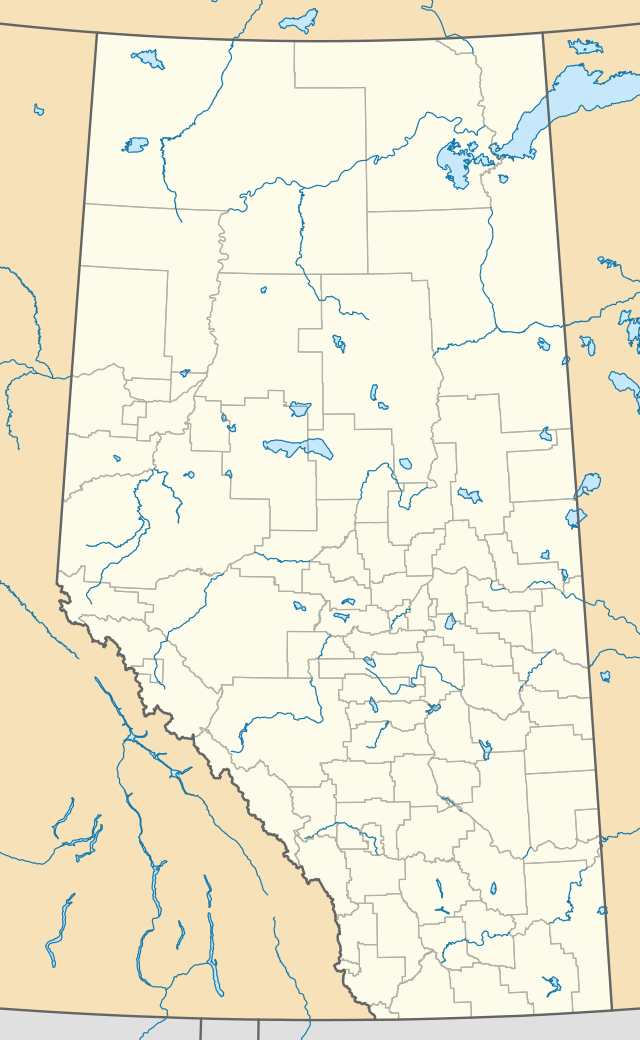Neptuak Mountain
Neptuak Mountain was named by Samuel E.S. Allen in 1894. "Neptuak" is the Stoney Indian word for "nine" as Neptuak Mountain is peak #9 in the Valley of the Ten Peaks. It is located on the Continental Divide, which is also the British Columbia-Alberta border in this region, and is in the Bow Range of the Park Ranges of the Canadian Rockies.[1][2] The summit is a tripoint for Banff National Park, Kootenay National Park, and Yoho National Park, where the three parks share a common border.
| Neptuak Mountain | |
|---|---|
 | |
| Highest point | |
| Elevation | 3,241 m (10,633 ft) [1] |
| Prominence | 151 m (495 ft) [2] |
| Parent peak | Deltaform Mountain[2] |
| Listing | Mountains of Alberta |
| Coordinates | 51°18′29″N 116°15′28″W [3] |
| Geography | |
 Neptuak Mountain Location on B.C. and Alberta border | |
| Country | Canada |
| Provinces | Alberta and British Columbia |
| Parent range | Bow Range |
| Topo map | NTS 82N/08 |
| Climbing | |
| First ascent | 1902 J. Norman Collie, H.E.M. Stutfield, G.M. Weed, H. Woolley, guided by C. Kaufmann[2] |
.jpg)
Geology
Like other mountains in Banff Park, Neptuak is composed of sedimentary rock laid down during the Precambrian to Jurassic periods.[4] Formed in shallow seas, this sedimentary rock was pushed east and over the top of younger rock during the Laramide orogeny.[5]
Climate
Based on the Köppen climate classification, Neptuak is located in a subarctic climate with cold, snowy winters, and mild summers.[6] Temperatures can drop below −20 C with wind chill factors below −30 C. Precipitation runoff from Neptuak drains east into tributaries of the Bow River, or west into tributaries of the Vermilion River.
See also
- Mountains of British Columbia
- List of peaks on the British Columbia-Alberta border
Further reading
- Bill Corbett, The 11,000ers of the Canadian Rockies, P 182
- Brian Patton, Parkways of the Canadian Rockies: A Touring Guide to Banff, Jasper, Kootenay, PP 76-77
- Kathy Calvert, Don Forest: Quest for the Summits, P 100
- Glen W. Boles, William Lowell Putnam, Roger W. Laurilla, Canadian Mountain Place Names: The Rockies and Columbia Mountains, P 100
References
- "Neptuak Mountain". PeakFinder.com. Retrieved 2009-02-24.
- "Neptuak Mountain". Bivouac.com. Retrieved 2009-02-24.
- "Neptuak Mountain". Geographical Names Data Base. Natural Resources Canada. Retrieved 2019-06-23.
- Belyea, Helen (1960). The Story of the Mountains in Banff National Park (PDF) (Report). Geological Survey of Canada. Archived (PDF) from the original on 2 October 2015. Retrieved 2019-06-23.
- Gadd, Ben (2008), Geology of the Rocky Mountains and Columbias
- Peel, M. C.; Finlayson, B. L. & McMahon, T. A. (2007). "Updated world map of the Köppen−Geiger climate classification". Hydrol. Earth Syst. Sci. 11: 1633–1644. ISSN 1027-5606.
External links
- National Park Service web site: Banff National Park
- National Park Service web site: Kootenay National Park
- National Park Service web site: Yoho National Park
- Neptuak weather: Mountain Forecast